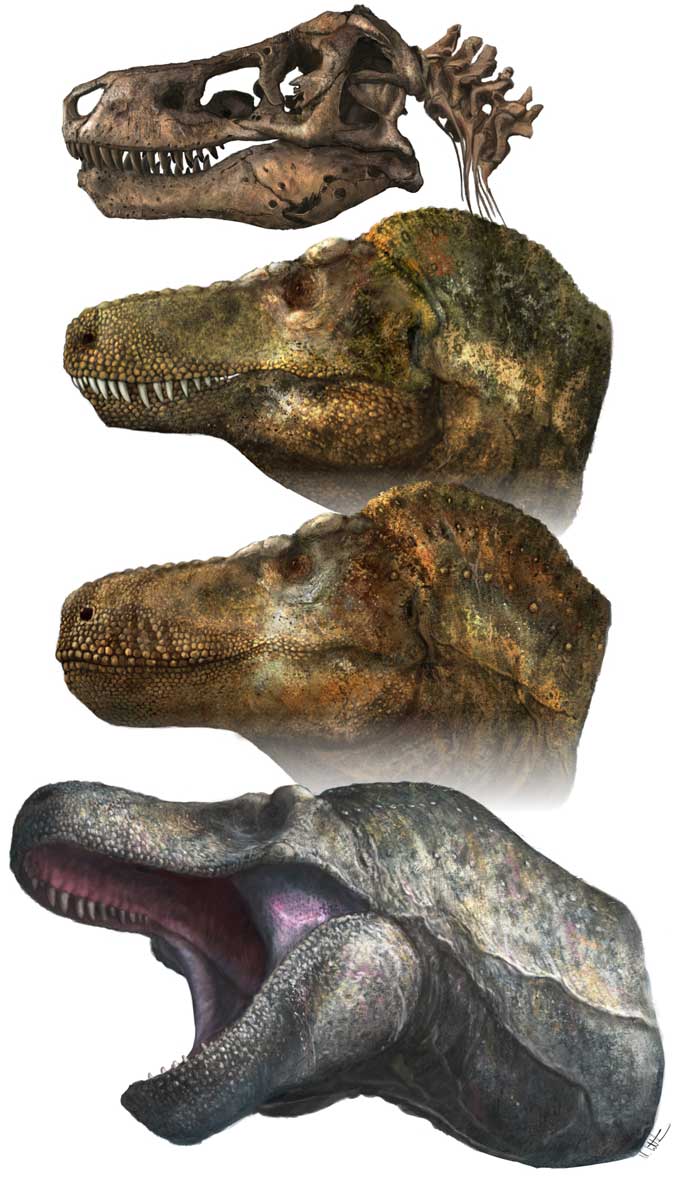In movies and TV shows, Tyrannosaurus rex often sports a fleet of big, sharp teeth that are almost always on display. But the dinosaurs and their kin may have kept their pearly whites mostly tucked behind lizardlike lips.
Similar to Komodo dragons today, these dinosaurs had ample soft tissue around the mouth that would have functioned as lips, an analysis of fossilized and modern reptile skulls and teeth finds. The research, described in the March 31 Science, challenges common, traditional reconstructions of how these top predators appeared in life.
“This is a nice, concise answer to a question that has been asked for a long time by dinosaur paleontologists,” says Emily Lessner, a vertebrate paleontologist at the Denver Museum of Nature and Science, who wasn’t involved in the study.
Soft tissue is not often included in analyses of the biomechanics of feeding dinosaurs, she says. Acknowledging the potential presence of lips in these tests could change how we think some dinosaurs ate.
It’s “not an unfair argument” to suggest that nonavian theropods, the dinosaur group that includes T. rex, might have had their chompers constantly exposed, says paleontologist Thomas Cullen of Auburn University in Alabama. Their sharp teeth tended to be large, potentially too big to fit fully in the mouth. And crocodiles and their ilk — theropods’ closest living relatives that have teeth — lack lips.
But almost all land vertebrates today have liplike coverings for their teeth, Cullen says. Why should Tyrannosaurus and other nonbird theropods be different?
Cullen and his colleagues analyzed fossilized theropod skulls and teeth alongside comparisons of living reptiles. The team examined the pattern of foramina, small passageways through bones, in the upper jaws of theropods and some modern and other extinct reptiles.
Foramina route blood vessels and nerves to the soft tissue around the mouth. In crocodilians, these foramina are scattered across the jaw. But in lipped reptiles like lizards, the little holes are arranged in a line along the edge of the jaw near the teeth Tyrannosaurus shares this row of jaw pores, the analysis showed.
Enamel in theropod and crocodilian teeth also yielded clues. When enamel dries out, it wears down more easily. The researchers found that the side of alligator teeth that are continually exposed erode more than the wetter side facing the inside of the mouth. Theropods have a more even wear pattern, suggesting the teeth were kept covered and moist.
And monitor lizards (Varanus spp.), which have proportionally long, serrated teeth much like theropods did, don’t decrease their lip coverage with increasing tooth and skull size, the researchers found. Because tooth length and skull size scale similarly in monitor lizards and theropods, the team says, there’s no reason to think that theropods couldn’t fit their teeth fully in their mouths too.
What’s more, the analysis revealed a neat row of jaw foramina in Hesperosuchus, an extinct, very early cousin of crocodilians. That finding suggests that lips may have been present in the earliest archosaurs — the group of reptiles that gave rise to dinosaurs (including birds) and crocodilians. The researchers think lips may have eventually been lost in the crocodilian lineages that survived to the modern day and lost in a separate process in birds.
But paleontologist Thomas Carr, who has studied tyrannosaurs, is not persuaded by the results. The new study “can be summed up in two words: completely unconvincing,” says Carr, of Carthage College in Kenosha, Wisc.
In 2017, he and his colleagues showed that tyrannosaurs had a rough, wrinkled surface texture to the jaw bones, and that crocodilians have this same bone texture underlying the lipless, scaly margins of their jaws (SN: 3/30/17).
“In many cases,” Carr says, “the soft tissues leave signatures on bone.” Those signatures can tell you what sat on top of the bone in animals whose skin or scales haven’t been preserved, he says. The new research “completely disregards … the texture of the facial bones, which unambiguously shows that [tyrannosaurs] had flat scales, like in crocodilians, all the way down to the edges of the jaws.”
This bone roughness isn’t a consistent feature in theropods, Cullen says. Young tyrannosaurs and smaller theropod species had smooth bones similar to a lizard’s. It’s possible that these animals had lips and then lost them over their life, but “I don’t think there is really any modern example of that kind of thing happening,” he says.
Something like the discovery of a mummified tyrannosaur carcass with preserved facial tissues, Carr says, could settle the matter of who had lips and who didn’t (SN: 10/12/22).


